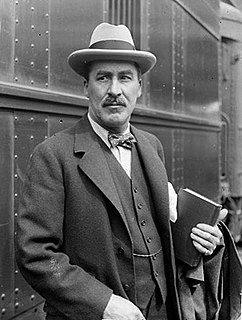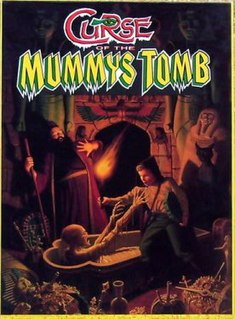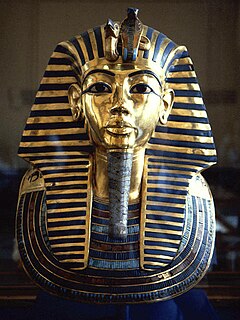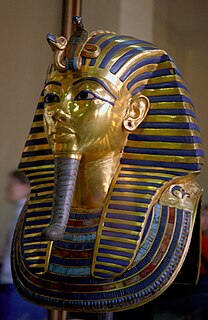
Wadjet is a board game similar to Clue that was published by Timbuk II in 1996.

Wadjet is a board game similar to Clue that was published by Timbuk II in 1996.
Wadjet is a board game for 2–4 players based on the discovery of the Tomb of Tutankhamun by Howard Carter and Lord Carnarvon in 1923. The board game is set some months after the discovery, when Carter had removed some of the treasures from the tomb. Someone has stolen twenty-five of them from the base camp, and the players take on the roles of archaeologists who are trying to recover the treasures.
The game box holds:
24 of the treasures are put into four tombs (6 per tomb). One treasure is sequestered away in a fifth tomb and becomes the treasure that must be found in order to win. Similar to the board game Clue, players accomplish this by entering the four tombs and finding the other treasures. Then by process of elimination, players can deduce which treasure lies in the 5th tomb. A player wins by accumulating at least $40,000 of treasures and correctly identifying which treasure is hidden in the 5th tomb.
Wadjet was designed by Dee Pomerleau and was published by Timbuk II in 1996.
The reviewer from Pyramid #28 (Nov./Dec., 1997) stated that "In short, this is one of the most pleasant games to look at you'll ever come across. The setting is equally appealing: the Carter archaeological dig which discovered King Tut's tomb in 1923." [1]
In a retrospective review written in 2014, the family game review site Growing Up with Games called the game "beautifully illustrated", and gave it a strong recommendation, saying, "Celebrate the discovery of the boy king’s tomb and dig up a vintage copy of Wadjet!" [2]

Howard Carter was an English archaeologist and Egyptologist. He became world-famous after discovering the intact tomb of the 18th Dynasty Pharaoh, Tutankhamun in November 1922, the best-preserved pharaonic tomb ever found in the Valley of the Kings.

Tutankhamun, Egyptological pronunciation Tutankhamen, commonly referred to as King Tut, was an ancient Egyptian pharaoh who was the last of his royal family to rule during the end of the 18th Dynasty during the New Kingdom of Egyptian history. His father was the mummy found in the tomb KV55, believed to be the pharaoh Akhenaten. His mother is his father's sister, identified through DNA testing as an unknown mummy referred to as "The Younger Lady" who was found in KV35.

Egyptology is the study of ancient Egyptian history, language, literature, religion, architecture and art from the 5th millennium BC until the end of its native religious practices in the 4th century AD. A practitioner of the discipline is an "Egyptologist". In Europe, particularly on the Continent, Egyptology is primarily regarded as being a philological discipline, while in North America it is often regarded as a branch of archaeology.

Saqqara, also spelled Sakkara or Saccara in English, is an Egyptian village in Giza Governorate, that's known for its vast, ancient burial ground of Egyptian kings and royals, serving as the necropolis for the ancient Egyptian capital, Memphis. Saqqara contains numerous pyramids, including the world-famous Step pyramid of Djoser, sometimes referred to as the Step Tomb, and a number of mastaba tombs. Located some 30 km (19 mi) south of modern-day Cairo, Saqqara covers an area of around 7 by 1.5 km.

George Edward Stanhope Molyneux Herbert, 5th Earl of Carnarvon, DL, styled Lord Porchester until 1890, was an English peer and aristocrat best known as the financial backer of the search for and excavation of Tutankhamun's tomb in the Valley of the Kings.

The tomb of young pharaoh Tutankhamun is located in the Valley of the Kings, near Thebes, Egypt. It is renowned for the wealth of valuable antiquities that it contained. Howard Carter discovered it in 1922 underneath the remains of workmen's huts built during the Ramesside Period; this explains why it was largely spared the desecration and tomb clearances at the end of the 20th Dynasty, although it was robbed and resealed twice in the period after its completion.

Infidel is an interactive fiction video game published by Infocom in 1983. It was written by Patricia Fogleman and Michael Berlyn and was the first in the "Tales of Adventure" line. It was released for the Amstrad CPC, Apple II, Atari 8-bit family, Commodore 64, IBM PC, TRS-80, and TI-99/4A. Ports were later published Macintosh, Atari ST, and Amiga. Infidel is Infocom's tenth game.

Tomb KV54 is located in the Valley of the Kings, in Egypt. It was originally excavated by Edward R. Ayrton on behalf of the American lawyer Theodore M. Davis, who funded the work.
Herbert Eustis Winlock was an American Egyptologist and archaeologist, employed by the Metropolitan Museum of Art for his entire career. Between 1906 and 1931 he took part in excavations at El-Lisht, Kharga Oasis and around Luxor, before serving as director of the Metropolitan Museum from 1932 to 1939.

Harry Burton was an English archaeological photographer and Egyptologist, best known for his photographs of excavations in Egypt's Valley of the Kings. His most famous photographs are the 1,400 he took documenting Howard Carter's excavation of Tutankhamun's tomb from 1922 to 1932.

The Curse of King Tut's Tomb is a 2006 adventure fantasy horror television film directed by Russell Mulcahy and starring Casper Van Dien, Leonor Varela, and Jonathan Hyde.

Curse of the Mummy's Tomb was a board game for 1-4 players, designed by Stephen Hand and published by Games Workshop. It featured a three-dimensional board, representing an Egyptian pyramid, with two consecutively smaller playing areas above the bottom board.

Pierre Lacau was a French Egyptologist and philologist. He served as Egypt's director of antiquities from 1914 until 1936, and oversaw the 1922 discovery of the tomb of Tutankhamun in the Valley of the Kings by Howard Carter.

The curse of the pharaohs or the mummy's curse is a curse alleged to be cast upon anyone who disturbs the mummy of an ancient Egyptian, especially a pharaoh. This curse, which does not differentiate between thieves and archaeologists, is claimed to cause bad luck, illness, or death. Since the mid-20th century, many authors and documentaries have argued that the curse is 'real' in the sense of having scientifically explicable causes such as bacteria or radiation. However, the modern origins of Egyptian mummy curse tales, their development primarily in European cultures, the shift from magic to science to explain curses, and their changing uses—from condemning disturbance of the dead to entertaining horror film audiences—suggest that Egyptian curses are primarily a cultural, not scientific, phenomenon.
Tutankhamun's mummy was discovered by English Egyptologist Howard Carter and his team on October 28, 1925 in tomb KV62 of Egypt's Valley of the Kings. Tutankhamun was the 13th pharaoh of the 18th Dynasty of the New Kingdom of Egypt, making his mummy over 3,300 years old.

Tomb of the Lost Queen is the 26th installment in the Nancy Drew point-and-click adventure game series by Her Interactive. The game is available for play on Microsoft Windows and Mac OS X platforms. It has an ESRB rating of E for moments of mild violence. Players take on the first-person view of fictional amateur sleuth Nancy Drew and must solve the mystery through interrogation of suspects, solving puzzles, and discovering clues. There are two levels of gameplay, Amateur and Master sleuth modes, each offering a different difficulty level of puzzles and hints, however neither of these changes affect the actual plot of the game. The game is loosely based on a book entitled Secrets of the Nile (1995).
This page lists major archaeological events of 2015.

The mask of Tutankhamun is a gold mask of the 18th-dynasty ancient Egyptian Pharaoh Tutankhamun. It was discovered by Howard Carter in 1925 in tomb KV62 in the Valley of the Kings, and is now housed in the Egyptian Museum in Cairo. The mask is one of the best-known works of art in the world and a prominent symbol of ancient Egypt.

Arthur Robert Callender, nicknamed 'Pecky', was an English engineer and archaeologist, best known for his role as assistant to Howard Carter during the excavation of Tutankhamun's tomb in the 1920s.
The archaeology of Ancient Egypt is the study of the archaeology of Egypt, stretching from prehistory through three millennia of documented history. Egyptian archeology is one of the branches of Egyptology.